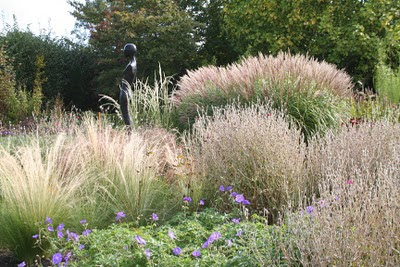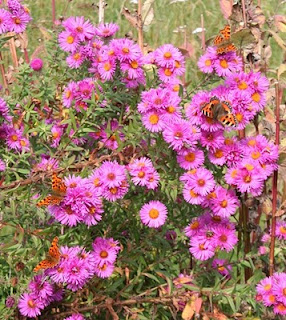I do love the garden in September. I know that it is past it’s colourful best and that there are gaps where earlier flowering plants have died back. But, rather like me at 50, the autumn garden is silvery, softening and running to seed. It has its own appeal and I like it very much.
The ongoing loan of Juliet Scott’s ‘Grace’ has given the square borders a natural focal point and she looks entirely at home set amongst the grasses. To the left is Stipa ‘Wind Whispers’ – a form of tenuissima, but the fronds keep a pleasing ‘combed through’ look all winter and don’t get the matted look of the parent. Top right is Miscanthus ‘Undine’. Lovely pinkish flowerheads, not too tall and emerging fairly early for a Miscanthus. The tall, fine fronds emerging from around the base of the sculpture are Stipa pseudoichu. A new one for me this year – I bought a few plugs in on an impulse from CGF and it has been gorgeous. I shall watch its performance through winter closely.
The same border looking down the garden to the gap in the yew hedge. (A reminder to me to increase the width of the Calamagrostis clumps next year)
Staying with the silvery theme, Lunaria rediviva was spared the dead-heading frenzy this year and now looks stunning, its long tapering papery pod centres glittering in the low light. Peter looked askance at the brown, dead looking pods I was so keen to keep. But I’ve been collecting the seeds carefully over the past couple of weeks, peeling off the outer cases with their sparse haul of seeds, leaving just the central oyster-shell parchment. It’s one of those fiddly jobs I like to do for a minute or two when I’m in a ponderous mood.
I spent a good few hours yesterday really studying areas of the garden, planning changes for next year. Mostly this is about aesthetics – my aim is to create a continuous sequence of vistas which work one after another as you wander round the garden. Different areas come into their own at different times of year, but it’s vital that none are ever ‘dead’ zones. So, for example, the exotic garden, which looks its best in late summer, has a late spring display of bold tulips and then giant alliums before the main event kicks in.
But for me it’s also about plant diversity and experimentation. It’s a big garden so I like to embrace all possible colours somewhere, including different flower forms, contrasting formality and informality. I enjoy the very, very tall (Peucedanum verticillare and Rudbeckia maxima) and the very tiny (Acaena microphylla). There are open areas and closed areas. Bold, colourful areas and cool restraint. The garden is eclectic, if you are being kind. Lacking a singularity of theme, if you are not. But I’m aware of this, and that it mustn’t be a mish-mash. I’m working on it. It will take time.
I managed a surprising amount of planning – actually writing things down and drawing too, but then got utterly distracted by the butterflies and general buzzing insectivorousness of the day. I spotted at least four Commas. This one is on Aster ‘Harrington’s Pink’
This bright pink aster was beseiged with butterflies and hoverflies all day. I don’t know which cultivar it is, but I was quite transfixed watching their endless, frenetic feeding. The compositae group of plants – daisies, if you prefer – are so important as a food source for butterflies. Every gardener should grow them, whether you like them or not. So there.
Now, you were going to get a lovely set of pictures of the apple trees, groaning with tantalising shiny red fruit. But uploading pictures for this one has been too tortuous for words. Some have been rotated against my will. Others I can’t post text next to. I don’t know why. But I’ve had enough of fighting it and I’m off to do a spot of gardening.




4 Responses to “Soft, soporific September”
Grace looks right at home in those lovely grasses… I'm sure she would like to stay there on permanent loan!
this looks really gorgeous…i want to dive into it (don't worry… i won't)
"running to seed" indeed! I don't think so! Great pictures Sue, the garden looks lovely
Laetitia – actually there's a path weaving through the grasses – so you can 'dive in' quite harmlessly